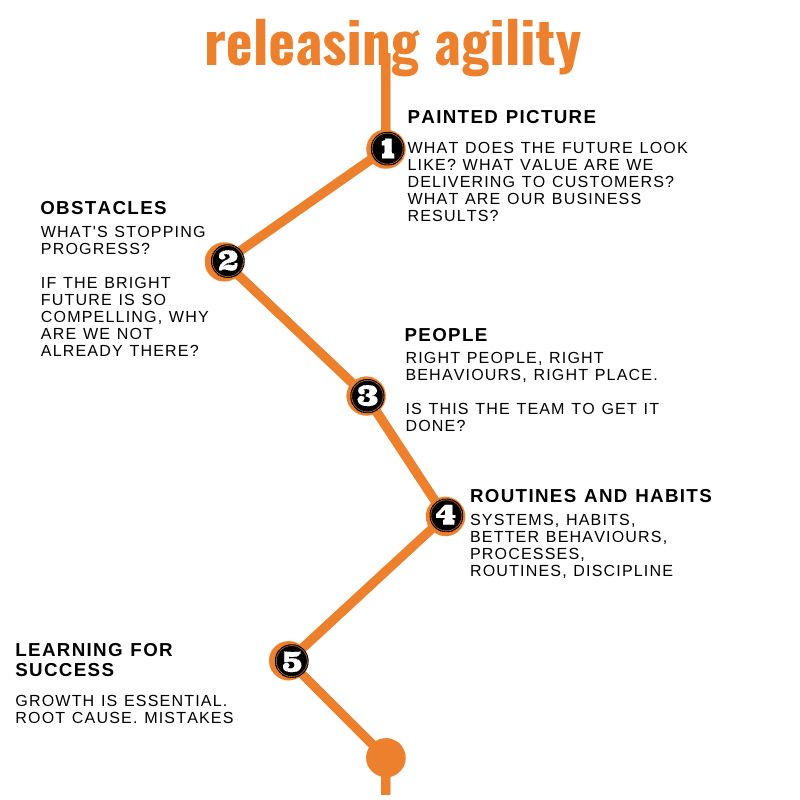Business Agility Basics - 8 big ideas about business agility

Releasing agility is what I do here at Cultivated Management and on this page you will find some Business Agility Basics.
No matter your industry, no matter your product, there is always agility to get you thinking about Releasing Agility in your organisation.
Agility Basics No. 1 – It’s all about Releasing Agility
The model I use with clients is based on 5 stages of thinking to help you frame business agility basics :

Step 1 – Do you have a Painted Picture of the Future?
- Why are you doing what you are doing?
- Does everyone in your team know what this bright future looks like?
- Are people aligned and energised to be working on this amazing bright future?
Step 2 – What obstacles are stopping you achieving this future state?
- If this bright future is so amazing, why are you not already there?
- In other words, what obstacles and problems do you need to work through?
- Is there a strategy explaining the bright future, the current reality and a plan to overcome these obstacles?
- This requires studying real problems; not myths, rumours, opinions and conjecture.
Step 3 – Build the team to get it done
- As a manager or leader you should be able to put your hand on your heart, look around at your team and say “This is the team to get it done”.
- If you can’t – you have some work to do – is that work being done?
- Your team need a plan – and this is where strong HR initiatives and competent management is crucial.
Step 4 – Define the behaviours, habits and routines for success
- Your culture is nothing more than group habit – it’s the sum of everyone’s behaviours.
- Do you know what behaviours you want? Which one’s you don’t want? And are your managers working to nudge these behaviours in the right direction?
- Are your managers role modelling these outstanding behaviours?
- This is also about “System of productivity”
- Are you adopting an off-the-shelf framework designed to solve problems you likely don’t have?
- No single methodology or approach is the right one for all – the best approach is the one that solves your problems
- Please don’t adopt an Agile Methodology unless you know for certain it solves the very problems you have identified – the chances are none of them will…..
Step 5 – Iterate, learn and improve
- Instigate on-the-job-training
- Make learning a core part of every conversation
- Conduct root cause analysis
- Get better – always
Agility Basics No. 2 – How to Release Agility in your organisation
In this video I walk through what Releasing Agility looks like, and how to start thinking about getting started.
If you’d prefer to read, then here is the article.
Agility Basics No. 3 – Some Guiding Principles of Agility
It’s great to be guided by general principles when you’re working on releasing agility – rather than hard and fast rules and frameworks.
Here are the principles.
If you’d prefer to read them – here is the article.
Agility Basics No. 4 – Agility belongs to managers and leaders
It’s my firm belief, that the way to release agility is through managers and leaders.
Agility requires knowing where you are going, knowing what’s stopping you from getting it done, instilling and role modelling the right behaviours and learning about the system of work.
All of which are Leadership and Management responsibilities.
Not only are they the responsibility of Leaders and Managers, but by careful studying you will spot levers to pull.
Levers that unleash great potential, remove giant blockers and open up the path way for Agility to pull (org structure, financial etc).
Agility Basics No. 5 – How to measure agility
I often get asked how to measure agility. Most people point me to maturity models and spider diagrams of agile “things”. After I stop laughing at these things, I offer the following 6 measures of Business Agility Basics:
1 – Your business results
I’m amazed at how few managers really know what they’re expected to deliver. What are your business results? What are you being paid to deliver? What will you get fired for not doing? They are the primary measure.
After all, there is little point in moving smoothly and quickly towards something else.
2 – Velocity
In a sense, a classic measure of agile, how fast are we delivering work.
3 – Throughput
How much work are we actually putting out? You need this to balance velocity. People are obsessed with speed, but there is little point in being quick if you’re not actually delivering business results. Tie throughput to your business results.
Again, no point being quick and delivering lots if it’s the wrong things.
Tie your speedy and eventful delivery to business results – always try to tie a threat between strategic goals, funding and delivery.
4 – Work in Process
How much work is currently being worked on, or is at least in the mix? Always too much. Multi tasking is not good when we’re trying to achieve flow. Smooth, consistent, sustainable flow. Peaks and troughs of massive delivery, then little delivery are common – limit how much work is in process/progress and focus on delivery,
5 – Cycle Time
How long does work take to go from start to deliver. You can measure cycle time at many places in the process, so choose ones that make sense, measure it and start improving it. Don’t set targets around it. Don’t pitch teams against each other. Measure and look for ways to improve.
Cycle time is the health of the system. How smoothly, quickly and consistently does it take for work to move through from idea to delivery?
6 – Failure Demand
How much of the work we are doing is failure related? As in, we didn’t do it right, or not at all, in the first place. John Seddon created this brilliant idea – and it works! In one team, 64% of the work was failure demand – work that they were doing from an earlier failure. Is that what we want our teams working on? Find the root cause and fix it. And let’s try and get our teams working on value demand.
Agility Basics No. 6 – To release agility unblock and solve the real problems
There’s a classic systems thinking idea that I’ve been practising for years – even before I had heard about it.
There are typically two main reasons facing a business
1 – Limits to growth and delivery
Many managers and leaders PUSH for more.
More people. More capacity. More work. More hours
The solution is NOT to push for more but to work out what is stopping growth and delivery – and remove these obstacles (or go around them).
Think confusion, lack of direction, competing goals, compensation that rewards bad behaviour, lack of decision making, too many governance boards, sporadic and disparate behaviours, low performance, old technology, poor process.
2 – Shifting of problems, failures and burdens
Many managers and leaders bring in coaches to solve management problems.
They engage in short term incentives that bring out the worst in people. They offer bonuses for delivery over systematically improving the process.
They embrace a Hero Culture, when they should be succession planning and mitigating against single points of failure.
They move people to the side, or even worse, other teams, instead of dealing with poor performance.
They buy off the shelf solutions, or silver bullet consultancy packages to work around problems that they should be solving.
The solutions is to address the real problems – and fix them.
After all, the easy solutions often lead to the problems of tomorrow.
Agility Basics No. 7 – Managers must stop destroying agility
Most organisations start out with immense amounts of agility. They have to.
Over time though this agility gets destroyed by well intentioned leaders and managers adding rules, regulations, handovers, functional budgeting etc.
As managers have stifled creativity and agility in the first place (through well intentioned illusions of control) – they can also then fix it.
Agility Basics No. 8 – Understand the delivery process to Release Agility
In order to understand the delivery process we are in charge of we must study it.
The best way to study it, map it out and then improve it is to staple yourself to work items and join them on their journey.
A technique I use is calling “Stapling”. Where we staple ourselves to the work and join it on its adventure through the system. We map it out, measure it and work out ways to gather people around improving it.
We can then visualise this process, cry a little, show others, and then see areas for improvement.
If you need any support when Releasing Agility and gaining a real business agility advantage – don’t hesitate to get in touch.
Of course, we could just cover off some business agility basics.


